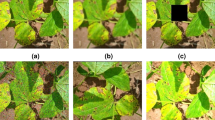Abstract
In identifying crop leaf diseases, Due to the complex nature of the disease symptoms. There may be variations in disease symptoms with similar characteristics and similarities in disease symptoms with different elements. This can make it challenging to differentiate between various diseases. CSASNet is a hybrid classification model proposed in this paper that combines the attention and multiscale feature fusion mechanisms. The model first incorporates the multiscale feature fusion module atrous spatial pyramid pooling (ASPP) into the ShuffleNetV2 network structure. This enriches the network with disease-specific multiscale feature information. Additionally, the model combines the special group-wise enhance (SGE) attention mechanism module to enhance the weight of disease spot feature information. Lastly, the leaky ReLU function replaces the original ReLU activation function. This allows the model to reduce damaging feature loss during training. The paper presents a design of multiple cross-validation experiments for comparison. The experimental results suggest that the improved model was used for disease leaf identification and showed an accuracy improvement on different crops. Compared to Convnext and MobileNetV2, the CSASNet model demonstrates higher recognition accuracy.












Similar content being viewed by others
REFERENCES
Cao, L., Real-time identification method of plant diseases and insect pests based on machine vision, Chin. Agric. Sci. Bull., 2015, vol. 31, no. 20, pp. 244–249.
Zhang, N., Donahue, J., Girshick, R., and Darrell, T., Part-based R-CNNs for fine-grained category detection, Computer Vision–ECCV 2014, Fleet, D., Pajdla, T., Schiele, B., and Tuytelaars, T., Eds., Lecture Notes in Computer Science, vol. 8689, Cham: Springer, 2014, pp. 834–849. https://doi.org/10.1007/978-3-319-10590-1_54
Girshick, R., Donahue, J., Darrell, T., and Malik, J., Rich feature hierarchies for accurate object detection and semantic segmentation, 2014 IEEE Conf. on Computer Vision and Pattern Recognition, Columbus, Ohio, 2014, IEEE, 2014, pp. 580–587. https://doi.org/10.1109/cvpr.2014.81
Branson, S., Van Horn, G., Belongie, S., and Perona, P., Bird species categorization using pose normalized deep convolutional nets, arXiv Preprint, 2014. https://doi.org/10.48550/arXiv.1406.2952
Branson, S., Beijbom, O., and Belongie, S., Efficient large-scale structured learning, 2013 IEEE Conf. on Computer Vision and Pattern Recognition, Portland, Ore., 2013, IEEE, 2013, pp. 1806–1813. https://doi.org/10.1109/cvpr.2013.236
Cui, Yi., Zhou, F., Wang, J., Liu, X., Lin, Yu., and Belongie, S., Kernel pooling for convolutional neural networks, 2017 IEEE Conf. on Computer Vision and Pattern Recognition (CVPR), Honolulu, Hawaii, 2017, IEEE, 2017, pp. 3049–3058. https://doi.org/10.1109/cvpr.2017.325
Zhang, Yi., Chu, J., Leng, L., and Miao, J., Mask-refined R-CNN: A network for refining object details in instance segmentation, Sensors, 2020, vol. 20, no. 4, p. 1010. https://doi.org/10.3390/s20041010
Lin, W., Chu, J., Leng, L., Miao, J., and Wang, L., Feature disentanglement in one-stage object detection, Pattern Recognit., 2024, vol. 145, p. 109878. https://doi.org/10.1016/j.patcog.2023.109878
Chen, J., Deng, X., Wen, Yu., Chen, W., Zeb, A., and Zhang, D., Weakly-supervised learning method for the recognition of potato leaf diseases, Artif. Intell. Rev., 2023, vol. 56, no. 8, pp. 7985–8002. https://doi.org/10.1007/s10462-022-10374-3
Sandler, M., Howard, A., Zhu, M., Zhmoginov, A., and Chen, L.-C., MobileNetV2: Inverted residuals and linear bottlenecks, 2018 IEEE/CVF Conf. on Computer Vision and Pattern Recognition, Salt Lake City, Utah, 2018, IEEE, 2018, pp. 4510–4520. https://doi.org/10.1109/cvpr.2018.00474
Wang, D., Wang, J., Ren, Zh., and Li, W., DHBP: A dual-stream hierarchical bilinear pooling model for plant disease multi-task classification, Comput. Electron. Agric., 2022, vol. 195, p. 106788. https://doi.org/10.1016/j.compag.2022.106788
Ma, N., Zhang, X., Zheng, H.-T., and Sun, J., ShuffleNet V2: Practical guidelines for efficient CNN architecture design, Computer Vision–ECCV 2018, Ferrari, V., Hebert, M., Sminchisescu, C., and Weiss, Y., Eds., Lecture Notes in Computer Science, vol. 11218, Cham: Springer, 2018, pp. 122–138. https://doi.org/10.1007/978-3-030-01264-9_8
Dai, Yi., Gieseke, F., Oehmcke, S., Wu, Yi., and Barnard, K., Attentional feature fusion, 2021 IEEE Winter Conf. on Applications of Computer Vision (WACV), Waikoloa, Hawaii, 2021, IEEE, 2021, pp. 3559–3568. https://doi.org/10.1109/wacv48630.2021.00360
Li, X., Hu, X., and Yang, J., Spatial group-wise enhance: Improving semantic feature learning in convolutional networks, arXiv Preprint, 2019. https://doi.org/10.48550/arXiv.1905.09646
Dubey, A.K. and Jain, V., Comparative study of convolution neural network’s ReLU and leaky-ReLU activation functions, Applications of Computing, Automation and Wireless Systems in Electrical Engineering, Mishra, S., Sood, Y., and Tomar, A., Eds., Lecture Notes in Electrical Engineering, vol. 553, Singapore: Springer, 2019, pp. 873–880. https://doi.org/10.1007/978-981-13-6772-4_76
Wang, G., Yu, H., and Sui, Yu., Research on maize disease recognition method based on improved ResNet50, Mobile Inf. Syst., 2021, vol. 2021, p. 9110866. https://doi.org/10.1155/2021/9110866
Atila, Ü., Uçar, M., Akyol, K., and Uçar, E., Plant leaf disease classification using EfficientNet deep learning model, Ecol. Inf., 2021, vol. 61, p. 101182. https://doi.org/10.1016/j.ecoinf.2020.101182
Liu, Zh., Mao, H., Wu, C.-Y., Feichtenhofer, Ch., Darrell, T., and Xie, S., A ConvNet for the 2020s, 2022 IEEE/CVF Conf. on Computer Vision and Pattern Recognition (CVPR), New Orleans, 2022, IEEE, 2022, pp. 11966–11976. https://doi.org/10.1109/cvpr52688.2022.01167
Iandola, F.N., Han, S., Moskewicz, M.W., Ashraf, Kh., Dally, W.J., and Keutzer, K., SqueezeNet: AlexNet-level accuracy with 50x fewer parameters and <0.5MB model size, arXiv Preprint, 2016. https://doi.org/10.48550/arXiv.1602.07360
Funding
This work was supported by ongoing institutional funding. No additional grants to carry out or direct this particular research were obtained
Author information
Authors and Affiliations
Corresponding author
Ethics declarations
The authors of this work declare that they have no conflicts of interest.
Additional information
Publisher’s Note.
Allerton Press remains neutral with regard to jurisdictional claims in published maps and institutional affiliations.
About this article
Cite this article
Lou Jianlou, Xuan, X., Guang, H. et al. CSASNet—A Crop Leaf Disease Identification Method Based on Improved ShuffleNetV2. Aut. Control Comp. Sci. 58, 408–419 (2024). https://doi.org/10.3103/S0146411624700524
Received:
Revised:
Accepted:
Published:
Issue Date:
DOI: https://doi.org/10.3103/S0146411624700524




